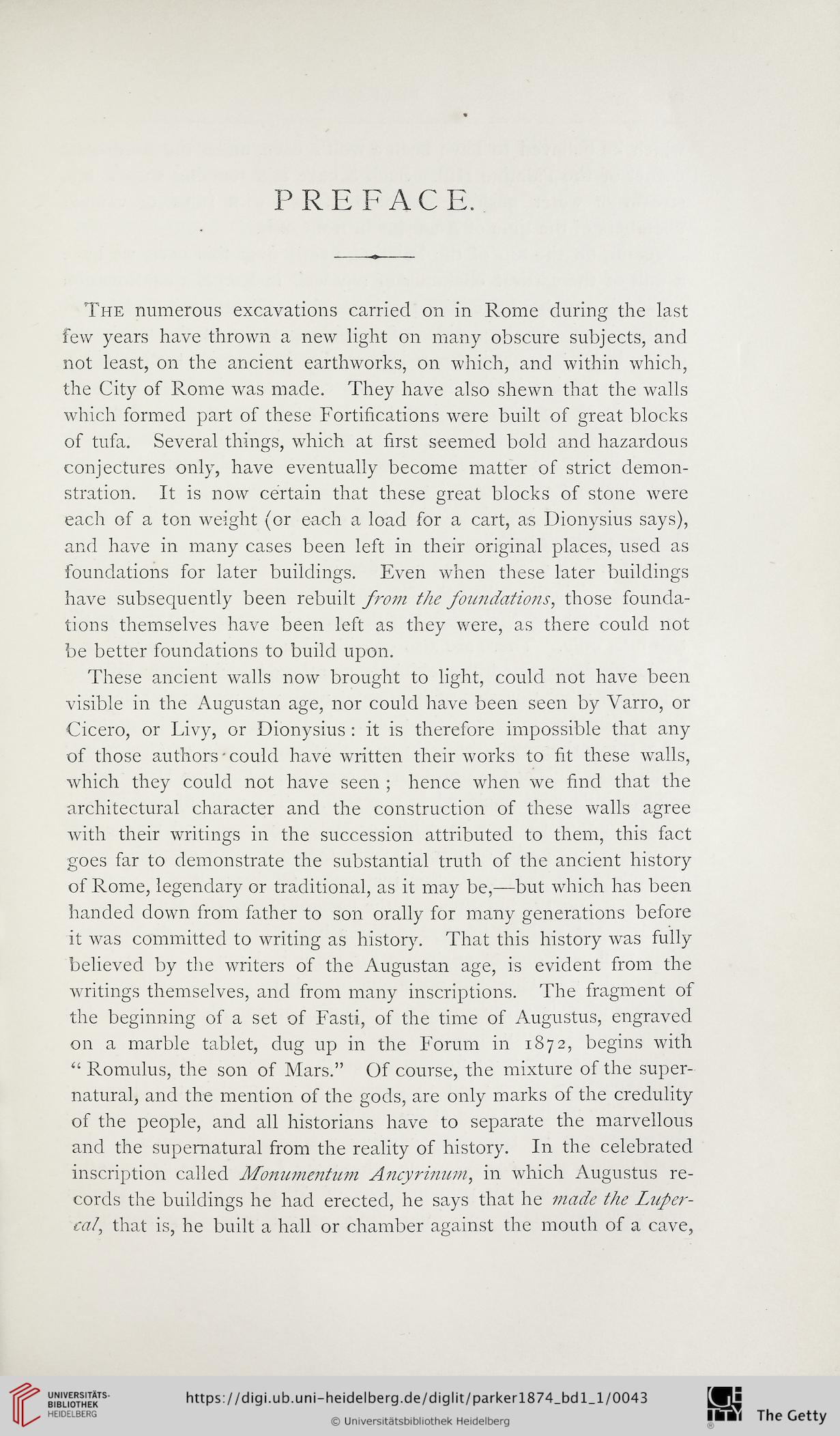PREFACE.
The numerous excavations carried on in Rome during the last
few years have thrown a new light on many obscure subjects, and
not least, on the ancient earthworks, on which, and within which,
the City of Rome was made. They have also shewn that the walls
which formed part of these Fortifications were built of great blocks
of tufa. Several things, which at first seemed bold and hazardous
conjectures only, have eventually become matter of strict demon-
stration. It is now certain that these great blocks of stone were
each of a ton weight (or each a load for a cart, as Dionysius says),
and have in many cases been left in their original places, used as
foundations for later buildings. Even when these later buildings
have subsequently been rebuilt from the foundations, those founda-
tions themselves have been left as they were, as there could not
be better foundations to build upon.
These ancient walls now brought to light, could not have been
visible in the Augustan age, nor could have been seen by Varro, or
Cicero, or Livy, or Dionysius : it is therefore impossible that any
of those authors • could have written their works to fit these walls,
which they could not have seen ; hence when we find that the
architectural character and the construction of these walls agree
with their writings in the succession attributed to them, this fact
goes far to demonstrate the substantial truth of the ancient history
of Rome, legendary or traditional, as it may be,—but which has been
handed down from father to son orally for many generations before
it was committed to writing as history. That this history was fully
believed by the writers of the Augustan age, is evident from the
writings themselves, and from many inscriptions. The fragment of
the beginning of a set of Fasti, of the time of Augustus, engraved
on a marble tablet, dug up in the Forum in 1872, begins with
“ Romulus, the son of Mars.” Of course, the mixture of the super-
natural, and the mention of the gods, are only marks of the credulity
of the people, and all historians have to separate the marvellous
and the supernatural from the reality of history. In the celebrated
inscription called Monumentum Ancyrinum, in which Augustus re-
cords the buildings he had erected, he says that he made the Lufer-
cal, that is, he built a hall or chamber against the mouth of a cave,
The numerous excavations carried on in Rome during the last
few years have thrown a new light on many obscure subjects, and
not least, on the ancient earthworks, on which, and within which,
the City of Rome was made. They have also shewn that the walls
which formed part of these Fortifications were built of great blocks
of tufa. Several things, which at first seemed bold and hazardous
conjectures only, have eventually become matter of strict demon-
stration. It is now certain that these great blocks of stone were
each of a ton weight (or each a load for a cart, as Dionysius says),
and have in many cases been left in their original places, used as
foundations for later buildings. Even when these later buildings
have subsequently been rebuilt from the foundations, those founda-
tions themselves have been left as they were, as there could not
be better foundations to build upon.
These ancient walls now brought to light, could not have been
visible in the Augustan age, nor could have been seen by Varro, or
Cicero, or Livy, or Dionysius : it is therefore impossible that any
of those authors • could have written their works to fit these walls,
which they could not have seen ; hence when we find that the
architectural character and the construction of these walls agree
with their writings in the succession attributed to them, this fact
goes far to demonstrate the substantial truth of the ancient history
of Rome, legendary or traditional, as it may be,—but which has been
handed down from father to son orally for many generations before
it was committed to writing as history. That this history was fully
believed by the writers of the Augustan age, is evident from the
writings themselves, and from many inscriptions. The fragment of
the beginning of a set of Fasti, of the time of Augustus, engraved
on a marble tablet, dug up in the Forum in 1872, begins with
“ Romulus, the son of Mars.” Of course, the mixture of the super-
natural, and the mention of the gods, are only marks of the credulity
of the people, and all historians have to separate the marvellous
and the supernatural from the reality of history. In the celebrated
inscription called Monumentum Ancyrinum, in which Augustus re-
cords the buildings he had erected, he says that he made the Lufer-
cal, that is, he built a hall or chamber against the mouth of a cave,




